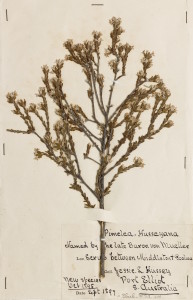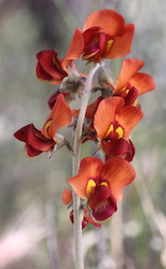 A symposium celebrating more than 60 years of the State Herbarium of South Australia.
A symposium celebrating more than 60 years of the State Herbarium of South Australia.
On Thursday and Friday the 14–15 April, 2016, the SA NRM Science Conference will host a special symposium to celebrate the Past, Present and Future of Botanical Research associated with the State Herbarium of South Australia. Some 26 presentations will be given, many of which will be available via live streaming if you can’t be there in person: here are the details on live streaming access.
The symposium covers diverse topics from the history of botanical collections, the botanical gardens, the Waite Arboretum and other collections in the state, palaeo-botany, molecular genetics, vegetation historical reconstruction, the seed bank, lichens, bryophytes, vascular plant diversity and some of the interesting plants that exist in South Australia, and more… Details of the symposium are available now.
The State Herbarium celebrated the 60th Anniversary of its formal establishment in December 2014. The State Herbarium collections was initially built from collections formerly held by the Museum of South Australia (which included Botanic Gardens collections) and the Botany Department at The University of Adelaide. In addition, an active collecting program was undertaken by early staff at the State Herbarium.
 Today, more than one million specimens of plants, algae, fungi and lichens are curated by the State Herbarium. They date back to a few collections made by Banks and Solander on Cook’s voyage and repatriated collections made on the Flinders Expedition representing the first collections in South Australia by Europeans. As such we are the fourth largest herbarium in Australia.
Today, more than one million specimens of plants, algae, fungi and lichens are curated by the State Herbarium. They date back to a few collections made by Banks and Solander on Cook’s voyage and repatriated collections made on the Flinders Expedition representing the first collections in South Australia by Europeans. As such we are the fourth largest herbarium in Australia.
Among the treasures of our collections are specimens from early scientific expeditions to the interior regions of northern and western Australia and major initiatives in surveying biodiversity:
- Elder Exploring Expedition (1891–2) [principal collector Richard Helms]
- Horn Expedition (1894) [principal collector Ralph Tate]
- Calvert Expedition (1896–7) [collector George Keartland]
- Simpson Desert Expedition of 1939 [Madigan Expedition]
- Arnhem Land Expedition of 1948 [principal collector Ray Specht]
- South Australian Biological Survey Program 1983–2010
- Weeds collections initiative [2009–ongoing]
The State Herbarium of South Australia in the future should continue to be a caretaker, provider and generator of core, foundational botanical knowledge in South Australia for the betterment of the community as a whole.
In the future the State Herbarium of South Australia will aim to continue:
- As a provider of core environmental knowledge—our specimen records are available and used, locally, nationally and globally;
- To provide an up to date Flora of South Australia for the accurate identification of plants found in South Australia;
- As a source of reference material to compare plant biodiversity in the past, present and future;
- As a repository of specimens representing the physical presence of plants in a particular place and a particular time;
- As an important partner in plant biodiversity and biodiscovery research;
- As a provider of taxonomic advice, education and decision making for the State of South Australia, including the identification of new weeds;
- To be the source of evidence for plants being found in South Australia and the regions they occur in;
- As a provider of taxonomic, systematic and botanical research on the plants of South Australia.
 Following the symposium, a special issue of the Journal of the Adelaide Botanic Gardens, to be renamed Swainsona, after the genus name of our states floral emblem, Sturt’s desert pea, Swainsona formasa, will be published containing short review papers of many of these presentations.
Following the symposium, a special issue of the Journal of the Adelaide Botanic Gardens, to be renamed Swainsona, after the genus name of our states floral emblem, Sturt’s desert pea, Swainsona formasa, will be published containing short review papers of many of these presentations.
We hope you attend in person or virtually in some form.
Michelle Waycott
Chief Botanist, State Herbarium of South Australia
